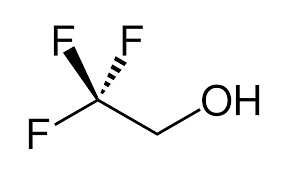HI! I’M ELEMENT AI.
2,2,2-Trifluoroethanol

Product Description
2,2,2-Trifluoroethanol, also known as trifluoroethyl alcohol, is a chemical compound with several industrial applications.
Product:
2,2,2-Trifluoroethanol
CAS:
75-89-8
Synonym:
Trifluoroethyl alcohol
Structure:

Typical Characteristics
Appearance
Colorless liquid
Boiling point
74 °C
Density
1.325 g/cm3
Melting point
−44 °C
Molecular Weight
100.04
Odor
Ethanol-like odor
Purity
≥99%
Refractive index
1.3
Uses, Applications & Markets
Key applications
get a quote
We Offer 2,2,2-Trifluoroethanol
in various grades
A few of the grades available are listed below:



2,2,2-Trifluoroethanol used in many
industry applications
2,2,2-Trifluoroethanol, also known as trifluoroethyl alcohol, is a chemical compound with several industrial applications. Here are some of its main uses:
- Chemical Synthesis: 2,2,2-Trifluoroethanol serves as a versatile building block in organic synthesis. It is employed in the production of pharmaceuticals, agrochemicals, and specialty chemicals. Trifluoroethyl alcohol can undergo various chemical transformations, including esterification, etherification, and oxidation reactions, to generate a wide range of fluorinated compounds with unique properties and functionalities.
- Solvent: It is utilized as a solvent in organic synthesis, particularly for reactions involving fluorinated compounds. 2,2,2-Trifluoroethanol exhibits excellent solvating power for polar and nonpolar substances, making it suitable for dissolving a wide range of organic and inorganic compounds. It is commonly used as a reaction medium in peptide synthesis, nucleic acid chemistry, and organometallic reactions.
- Protein Folding and Stability: Trifluoroethyl alcohol is employed as a cosolvent or denaturant in protein biochemistry and biotechnology. It can disrupt hydrogen bonding and hydrophobic interactions in proteins, leading to changes in protein conformation and stability. 2,2,2-Trifluoroethanol is often used in studies of protein folding, unfolding, and aggregation kinetics.
- Pharmaceutical Formulations: It is used in the formulation of pharmaceutical products, particularly for the preparation of injectable solutions, oral suspensions, and topical formulations. 2,2,2-Trifluoroethanol can enhance the solubility, stability, and bioavailability of poorly soluble drugs by acting as a cosolvent or solubilizing agent.
- Peptide and Protein Chemistry: Trifluoroethyl alcohol is commonly employed in peptide synthesis and protein modification reactions. It can promote peptide bond formation and protect amino acid side chains during solid-phase peptide synthesis. Additionally, 2,2,2-Trifluoroethanol is used in protein crosslinking and labeling studies to probe protein structure, function, and interactions.
- Nucleic Acid Chemistry: It finds applications in nucleic acid chemistry and molecular biology techniques. Trifluoroethyl alcohol is used in the denaturation and hybridization of DNA and RNA molecules, as well as in the stabilization of nucleic acid secondary structures. It can disrupt hydrogen bonding in nucleic acids, facilitating DNA melting and RNA refolding processes.
- Fluorous Chemistry: 2,2,2-Trifluoroethanol is a key component in fluorous chemistry, a specialized branch of organic chemistry focused on the synthesis and separation of fluorinated compounds. It serves as a fluorous solvent or cosolvent in fluorous biphasic systems, enabling the purification and separation of fluorous-tagged molecules from nonfluorous components.
- Gas Chromatography: It is used as a derivatization reagent and solvent in gas chromatography (GC) analysis. Trifluoroethyl alcohol can react with functional groups in organic compounds to form volatile derivatives suitable for GC analysis. It is particularly useful for the analysis of polar and nonpolar analytes in complex mixtures.
- Surface Science and Nanotechnology: Trifluoroethyl alcohol is employed in surface science studies and nanomaterial synthesis. It can be used to functionalize surfaces, modify nanoparticle surfaces, and control surface wettability in applications such as thin film deposition, surface patterning, and nanolithography.
- Antifreeze Additive: It is used as an antifreeze additive in industrial cooling and heating systems to prevent freezing and corrosion. 2,2,2-Trifluoroethanol can lower the freezing point of water and inhibit the formation of ice crystals, providing freeze protection and thermal stability at low temperatures.